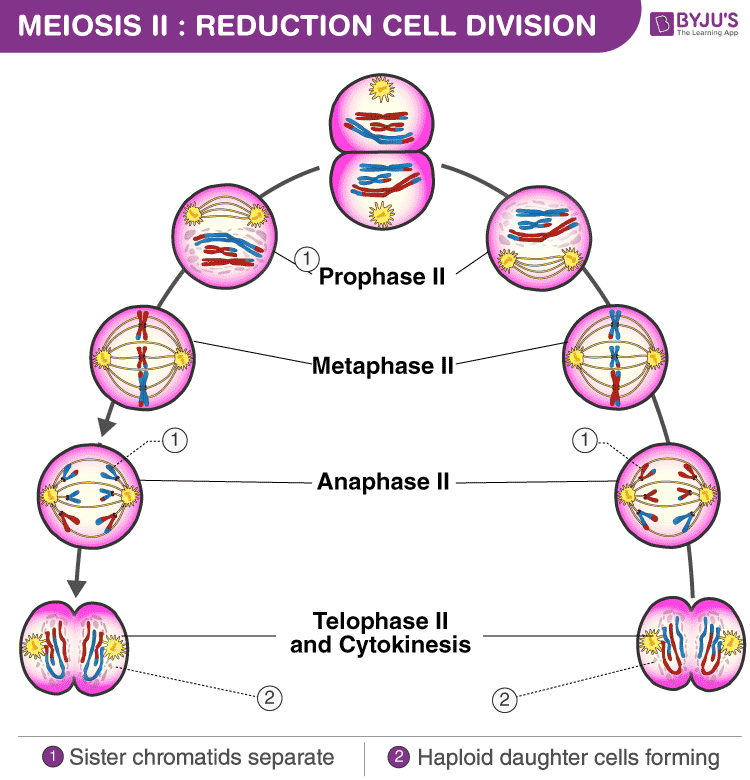Table of Contents
Meiosis consists of two cell divisions namely Meiosis 1 and Meiosis 2.
Phases of Meiosis I
There are 4 stages of meiosis, prophase is the longest meiosis stage and it comprises five sub-phases under it.
1) Prophase 1 –
Prophase 1 is the longest phase of meiosis where three primary aspects are taking place. The first is the condensation of chromatin into chromosomes, the second aspect is the physical contact between homologous chromosomes, and the third aspect is the transmission of genetic information between synapsed chromosomes. All these aspects occur in five sub-phases. The following are the five sub-phases under prophase 1:
- Leptotene: The chromosomes start to condense and attach to the cell membrane through a cap-like structure at the end of chromosomes called telomeres.
- Zygotene: Here the chromosomes start pairing and synapsis between homologous chromosomes begins. The synapsis forms all over the chromosomes, creating numerous points of contact called the synaptonemal complex. It is called a zip-like structure because of several coils of chromatin. The synaptonemal complex helps to hold the aligned chromosomes together and facilitates synapsis. The paired chromosomes are called bivalents.
- Pachytene: Here, the synapse is formed, by a chromatid of one pair attaching to the chromatid in a homologous chromosome and the crossing over begins. After some time, the synapses snap, finishing the process of crossing over of the genetic information. Non-sister chromatids of homologous chromosome pairs exchange segments or parts and Chiasma is formed in these exchanged regions. Basically, the crossing over of genetic material between the non-sister chromatids occurs in this phase.
- Diplotene: Here, the paired chromosomes start to separate from each other into two pairs of chromatids. The synapsis stops with the disintegration of the synaptonemal complex. The homologous pairs of chromosomes remain attached at Chiasma. The chromosomes begin to coil, making the Chiasma very evident under the microscope.
- Diakinesis: The chromosomes are at their most condensed form in this phase. The homologous pairs of chromosomes in a bivalent are connected by one chiasma. The nuclear membrane disintegrates before Metaphase 1, the nucleolus vanishes and centrioles move to the equator.
Also Refer: What are the sub-stages of prophase 1 of Meiosis 1?
2) Metaphase 1:
In this meiosis phase, the pairs of homologous chromosomes move up the equator of the cell and line up on the metaphase plate. The process is called random assorting where maternal and paternal chromosomes line up in random order, aligning themselves on either side of the equator, which leads to genetic diversity among offspring.
3) Anaphase 1:
The two chromosomes of bivalent separate and move to the opposite sides of the cell. Non-sister chromatids stay connected whereas homologous chromosomes are separated.
4) Telophase 1:
In this meiosis phase, the decondensation of chromosomes occurs., later the chromosomes are completely separated and the nuclear envelope forms. Cytokinesis is the process where the plasma membrane is divided into two daughter cells.
Explore More: Meiosis I: Reductional Cell Division
Phases of Meiosis II

In this meiosis phase 2, which is the second meiotic division, the non-sister chromatids completely separate. The four aspects of Meiosis 2 are Prophase 2, Metaphase 2, Anaphase 2 and Telophase 2. The stages of meiosis 2 are as follows:
- Prophase 2:Here, we see the nucleoli and nuclear membrane disappear again. The chromatids get shorter and thicker. Chromosomes condense and centrosomes move to the opposite sides of the cell.
- Metaphase 2:The centrosomes have two kinetochores that attach to spindle fibres from the centrosomes at opposite ends of the cell.
- Anaphase 2:Here, the spindle fibres contract and separate from non-sister chromatids. These separated chromatids move to the opposite ends of the cell. The chromatids are now called sister chromosomes as they are at the equator of the cell.
- Telophase 2:This stage is similar to the telophase 1 stage in Meiosis 1. Here, the chromosomes decondense, the nuclear membrane reforms and cell plate formation creates four haploid daughter cells.
Explore More: Meiosis ll: Reduction Cell Division
Explore more related topics by registering at BYJU’S Biology.
Frequently Asked Questions – FAQs
Why is meiosis II considered similar to mitosis?
How do the haploid cells formed during meiosis but why is this not happening in mitosis?
Meiosis produces 4 haploid cells. Mitosis produces 2 diploid cells. The old name for meiosis was reduction/ division. Meiosis I reduces the ploidy level from 2n to n (reduction) while Meiosis II divides the remaining set of chromosomes in a mitosis-like process (division).

Comments